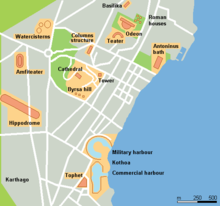

Approximately 100 years after the destruction of Punic Carthage in 146 BC, a new city of the same name (Latin Carthāgō) was built on the same land by the Romans in the period from 49 to 44 BC. By the 3rd century, Carthage had developed into one of the largest cities of the Roman Empire, with a population of several hundred thousand.[1] It was the center of the Roman province of Africa, which was a major breadbasket of the empire. Carthage briefly became the capital of a usurper, Domitius Alexander, in 308–311. Conquered by the Vandals in 439,[2] Carthage served as the capital of the Vandal Kingdom for a century. Re-conquered by the Eastern Roman Empire in 533–534, it continued to serve as an Eastern Roman regional center, as the seat of the praetorian prefecture of Africa (after 590 the Exarchate of Africa). The city was sacked and destroyed by Umayyad Arab forces after the Battle of Carthage in 698 to prevent it from being reconquered by the Byzantine Empire.[3] A fortress on the site was garrisoned by Muslim forces[4] until the Hafsid period, when it was captured by Crusaders during the Eighth Crusade. After the withdrawal of the Crusaders, the Hafsids decided to destroy the fortress to prevent any future use by a hostile power.[5] Roman Carthage was used as a source of building materials for Kairouan and Tunis in the 8th century.[6]
- ^ Likely the fourth city in terms of population during the imperial period, following Rome, Alexandria and Antioch, in the 4th century also surpassed by Constantinople; also of comparable size were Ephesus, Smyrna and Pergamum. Stanley D. Brunn, Maureen Hays-Mitchell, Donald J. Zeigler (eds.), Cities of the World: World Regional Urban Development, Rowman & Littlefield, 2012, p. 27
- ^ Peter Heather (2010). The Fall of the Roman Empire: A New History. Pan Macmillan. p. 402. ISBN 9780330529839.
- ^ Cite error: The named reference
Edmundwas invoked but never defined (see the help page). - ^ Cite error: The named reference
Edigupliawas invoked but never defined (see the help page). - ^ Cite error: The named reference
Mustansirwas invoked but never defined (see the help page). - ^ Colum Hourihane (2012). The Grove Encyclopedia of Medieval Art and Architecture, Volume 1. Oxford University Press. ISBN 978-0-19-539536-5.
© MMXXIII Rich X Search. We shall prevail. All rights reserved. Rich X Search
